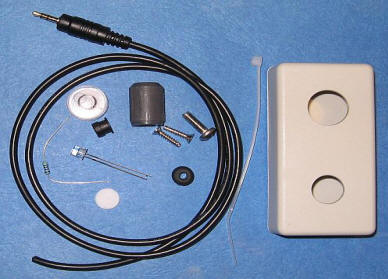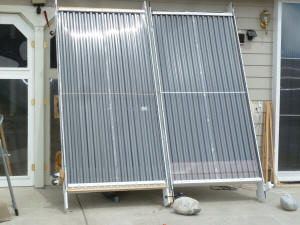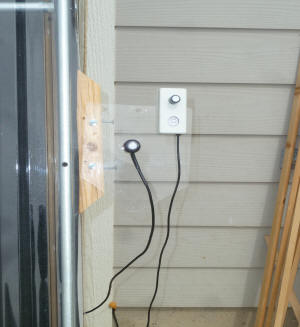Trying a Kit Pyranometer
David Brooks offers some good material on pyranometers as well as a low
priced kit of parts that allows you to build a pyranometer here...
The kit is very simple, consisting of a 1% resistor hooked across
the output of a silicon cell. The solar radiation on the silicon cell
generates a current through the resistor that is proportional to the solar
radiation. You measure or log the voltage across the resistor and
calibrate this to the solar intensity.
The kit includes a holder for the silicon cell and a diffuser disk made
from Teflon that gets installed over the silicon cell. There is also a
bubble level to make it easier to level the pyranometer.
The assembly instructions are good. The only small difficulty I had
was that the Teflon diffuser pad did not want to seat in the recess of the
silicon cell holder -- it was just a little to large. I ended up
applying some pressure on the disk by putting the whole assembly in a vice
and gently applying some pressure until it snapped in.
Once you have the pyranometer assembled, there are two challenges to
using it. The first is that you have to have a way to measure the
output voltage of the pyranometer (which ranges from about zero to 0.25
volts), and the 2nd is that you have to have a way to calibrate this output
voltage to the actual level of solar radiation.
David used an
Onset Computer U12 logger to measure and log the pyranometer output
voltage, and this is what I did as well. This works fine, but it does
require you to buy the U12 logger and software, which will run about $200.
The U12 is a good general purpose logger that can be used for many things,
but if you don't want to purchase the logger, you could just measure the
voltage across the resistor with a good multimeter. You would need a
meter that will accurately measure voltages around 0.2 volts to within about
0.002 volt.
The other challenge is that you need a way to calibrate the output
voltage of the kit pyranometer to the solar intensity. If you have
access to an accurate pyranometer, the easiest way to do the calibration
would be to set the two up next to each other and measure sun levels over a
few hours -- say from noon to near sunset. This will allow you
to calibrate the voltage output to the actual pyranometer readings.
For example, if when the pyranometer reads 900 watts/sm the kit pyranometer
voltage output is 0.2 volts, then the calibration constant is (900 watts/sm)/(0.2
volts) = 4500 watts/sm per volt. You would want to compare
the reference pyranometer to the kit pyranometer at several sun levels and
pick a good average calibration constant.
Since you probably don't have a pyranometer available, what are the other
options for calibration?
David offers this procedure for calibrating the kit pyranometer:
If you mount the pyranometer horizontally at a
site where there are relatively few obstructions to the horizon, you can use
a calibration based on a clear-sky model for insolation. There are two such
models here:
http://www.instesre.org/Solar/Solar_home_page.htm
I usually the one in the link to "A simple clear-sky insolation model."
If you get a couple of really clear cloud-free days, you can get a pretty
good calibration.
As another alternative, you may be able to find a place that records solar radiation values that
is close to your location. You could then use the solar radiation
values they publish compared to the voltage readings on your kit pyranometer
for the same time period to do the calibration. I
don't know how much error you incur as the distance from the measuring
station to your location increases, and it probably depends a lot on local
conditions. You might consider moving your kit pyranometer to
their location and doing the calibration in their front yard. I also
don't know how many locations there are where actual solar radiation
measurements are taken -- something to look into -- please let me know if
you find some good material on this.
I can point out from personal experience that solar radiation values vary
by a significant amount from one apparently sunny day to another, and that
even readings over a few minutes can vary significantly -- clouds that are
nearly impossible to see with the eye can have a significant effect.
Something to bear in mind when figuring out how to calibrate.
Another approach would be to just use the calibration constant that David
came up with on the kit pyranometer that he tested. This assumes that
the silicon cells are very consistent, which may or may not be true.
The calibration constant that David got was 4800 watt/sm per volt. In
my short test I got 4650 watts/sm per volt. So, this is only about a
3% difference. In the world of pyranometers this is really
pretty close. We both used Apogee pyranometers for the reference, and
the two Apogees could easily be 3% different from each other.
Note: David does not recommend this approach because in general, the
cells differ quite a bit from cell to cell.
My Test of the Kit Pyranometer
I use the pyranometer to record solar radiation on the front face of
solar heating collectors, so the pyranometer is mounted in the same plane as
the collector glazing. This gives a more accurate reading than
mounting the pyranometer horizontally and then calculating the radiation on
the glazing plane. So, the kit and Apogee pyranometers are mounted on
a scrap of plastic that is screwed into the collector frame such that the
pyranometers are in the same plane as the collector glazing.
The voltage output of the kit pyranometer and the output of the Apogee
pryranometer a logged and plotted. My Apogee pryranometer model has a
built in amplifier that is calibrated to give 2.5 volts at 1250 watts/sm,
and this calibration constant is entered into the logger software so that
the Apogee reads directly in watts/sm. The same could be done for the
kit pyranmeter once the calibration constant is determined.

The two test collectors. |

Apogee and kit pyranometers mounted side by side
in the plane of the collector. |

The plot shows the output of the kit pyranometer in volts (blue) compared
to the Apogee pyranometer in watt/sm (green).
I've adjusted the Volts axis scale so that by eyeball the two curves
match each other pretty well. This gives a calibration constant of
1000 watts/sm for 0.215 volts, or 4650 watts/sm per volt. This
compares to the 4800 watts/sm per volt that David recorded on his test.
Pretty close given that this is two different silicon cells and two
different Apogee pyranometers.
There is some variation in the relationship between the two pyranometers
over the period of the test, but, it seems to me, that the two track quite
well and for things like collector testing the kit pyranometer would be just
fine once a way of calibrating it is worked out.
I'd be interested in hearing any thoughts/comments/experiences you might
have on the test or the two pyranometers.
Gary May 13, 2011


